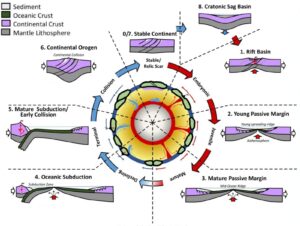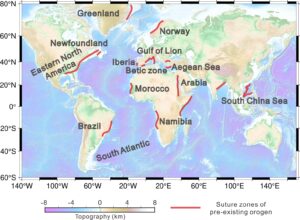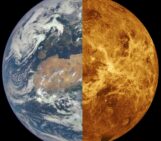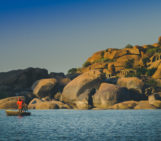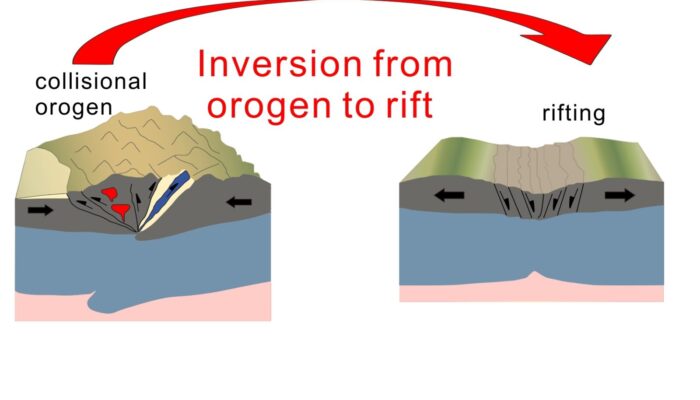
In this new blog, Dr. Kai Li (GFZ Potsdam) talk about his PhD work, where he used accordion numerical models to explore the tectonic history of the South China Sea. His PhD research focuses on the impact of orogenic inheritance on rifts and rifted margins, employing advanced geodynamic modeling techniques.
Have you ever tried to fit the west coast of Africa and the east coast of South America together like puzzle pieces? I remember doing that back in junior high geography class, learning about Alfred Wegener’s 1912 theory of continental drift. This simple exercise revealed a profound truth: the continents move. What was once a single supercontinent gradually split apart, shaping the world as we know it today. The matching coastlines whisper of the Earth’s deep memory, with its tectonic past etched onto the surface like entries in an ancient diary. However, continental drift is merely the beginning of the story. In the 1960s, geophysicist J. Tuzo Wilson discovered a larger pattern: rifting and continental convergence are not random events, but follow a cyclical rhythm known as the ‘Wilson Cycle’.
The Wilson Cycle describes the rhythm of tectonic activity on Earth. This includes ocean closure, mountain building, rifting and the formation of mature oceans. According to this theory, mountain ranges are formed when ancient oceans close (Stage 6 in Figure 1). Interestingly, new oceans often open along the scars of these old mountains (Stage 1). This cycle illustrates the continuous evolution of the Earth’s surface over hundreds of millions of years. However, a key question remains: how does the ancient mountains influence the formation of new oceans? During my PhD, I investigated the impact of remnants of past orogens on continental breakup and the architecture of rifted margins using a combination of numerical modelling and geological observation (Li et al., 2024).
The Hidden Memory of Orogens
Take a look at the global map in Figure 2. The red lines mark the suture zones of ancient orogens—the memory of long-gone mountain belts (Buiter et al., 2014). Interestingly, many of today’s rifts and rifted margins developed precisely along these zones. Notable examples include the northern margin of the South China Sea, the Gulf of Lion, the Aegean Sea, and both sides of the Atlantic Ocean.
Among these, the South China Sea stands out as an ideal natural laboratory to study how orogenic “memory” influences continental rifting processes. It captures the transition from mountain building, continental breakup and ocean spreading. Located at the junction of the Pacific, Eurasian, and Indo-Australian plates, the South China Sea opened between ~33 and 15 million years ago, following a complex tectonic history. Before its formation, the region experienced late Mesozoic mountain building (around 100 Myr ago) originated from upper-plate compression related to the NW-ward subduction of the Paleo-Pacific Plate. It is followed by Paleogene extension (around 65 Myr ago) (Holloway 1982, Li et al. 2014), which ultimately led to breakup in the early Oligocene (33 Myr ago Briais and Tapponnier, 1993).
Modelling the Geological Story of the South China Sea
We employ a two-way coupling strategy (Neuharth et al., 2022) to link the geodynamic finite element code ASPECT with the landscape evolution model FastScape. ASPECT solves for mass, momentum, and energy conservation considering visco-plastic rheology, while FastScape models fluvial incision, hillslope diffusion, and fluvial and marine sedimentation.
Do you know the instrument accordion? When played, it expands and contracts rhythmically, producing a dynamic and recognizable sound. Inspired by this motion, we designed an “accordion model” to simulate the tectonic evolution of the South China Sea (SCS), where the lithosphere underwent shortening and extension before the sea spreading. In our numerical model, we only change the velocity boundary conditions on the left and right sides to represent plate motion through time. The system then evolves self-consistently, governed entirely by the internal physics of lithospheric deformation and surface processes.
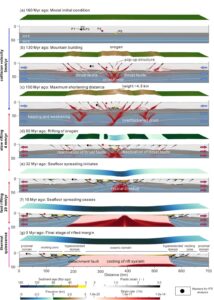
Figure 3. The accordion model to simulate the evolution of the history of the South China Sea (Li et al., 2024). Particles labelled P1 to P5 are used for tracking the P-T-t path. The arrows indicate boundary velocities (e.g., blue for convergence, red for extension). Accumulated plastic strain is shown in black shades, representing brittle faults. Elevation is taken from the FastScape model.
Our model captures this geological events in four stages, reflecting the complex tectonic history of the region:
- Stage 1 – Orogeny (160–100 Myr ago):
A convergent velocity boundary condition (the blue arrows) with 5 mm/yr leads to the formation of a well-developed collisional orogen in the model’s central domain. This stage is marked by thrust faulting, crustal thickening, and mountain building with highest topography around 4.5 km (Figure 3c).
- Stage 2 – Slow Extension (100–32 Myr ago):
As boundary velocity reverses (the red arrows), the orogen begins to collapse under its own weight due to gravitational spreading. With slow extension at 4 mm/yr, some pre-existing thrust faults become reactivated, creating a structurally complex rift zone (Figure 3d).
- Stage 3 – Fast Extension (32–15 Myr ago):
The rapid rifting phase (extension velocity of 20 mm/yr) begins 32 Myr ago shortly prior to the inception of continental breakup. And at 15 Myr ago seafloor spreading ceases (Figure 3f). The conjugate continental margins display distinct differences in width, geometry, and the distribution of basins.
- Stage 4 – Tectonic Quiescence (after 15 Myr ago):
Following the latest phase of fast extension, a 15 Myr period of tectonic quiescence occurs. During this final phase, the lithosphere gradually cools, and geothermal gradients decrease. Sediments continue to accumulate within the oceanic basins along the rifted margins in undisturbed sub-horizontal layers (Figure 3g).
Our model accurately replicates key structural features and thermal histories of the South China Sea, closely matching geophysical and thermochronological observations (detailed comparison see Li el al., 2024), thereby demonstrating the accordion model’s robustness in capturing the complex lithospheric evolution of rifted margins formed on mountain belts.
Crustal Breakup: Parameter test
To explore the physical controls behind orogenic structures and crustal breakup, we carried out several accordion-style numerical models. The three representative results help us arrive at a universal conclusion about the link between mountain building and continental rupture. The red line marks where crustal breakup eventually occurs during rifting (Figure 4), allowing us to track how orogens grow, collapse, and continent rupture through time (see Li et al., 2024 for full details).
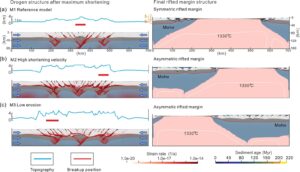
Figure 4. Alternative models illustrating how orogenic topography controls the final location of breakup. Importantly, the location of continental breakup always matches one of the highest mountain ranges (Li et al. 2024).
Despite the variations in setup, all models consistently show one thing: crustal breakup localizes in areas with high topography, high gravitational potential energy, and thickened crust. These results highlight the fundamental role of orogenic memory in determining the location and mechanism of continental separation. Interesting right? Now let’s understand why.
Why does continental breakup occur in orogenic belts during the transition from mountain building to rifting?
To better understand why crustal breakup consistently localizes beneath mountain belts, we identify three key mechanisms. We also use everyday analogies to explain these processes more intuitively.
(1). High Gravitational potential energy leads to orogenic collapse.
Imagine a pile of heavy rocks stacked on a steep hill. With just a small nudge, they tumble—not because of an external force, but because gravity compels motion. Similarly, in over-thickened mountain belts, gravity takes over (Figure 5b). The mountains collapse under their own weight, and gravity becomes the engine driving lithospheric extension.
This intuitive image captures a fundamental geodynamic process. During tectonic convergence, the shortening of the lithosphere causes the orogenic crust to thicken and to develop pronounced topography, forming towering mountain belts. These dramatic landscapes are not only visually impressive; they also store immense gravitational potential energy (GPE). As the crust grows thicker and topography rises, the energy stored within the orogen increases significantly. These high GPE gradients act as internal drivers of deviatoric stress in the gravitationally unstable crustal root (Schott & Schmeling, 1998; Zoback & Mooney, 2003), which sets the stage for orogenic collapse and even crustal breakup.
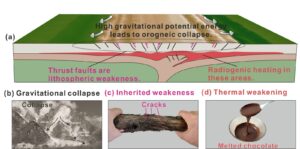
Figure 5. Explanation of how the crustal root of an orogen controls continental breakup during subsequent rifting. Panel (a) modified from Li (2025); panel (b) modified from Penna et al. (2021).
(2). Inherited thrust faults formed during mountain building act as lithospheric weak zones.
Consider a wooden stick with small cracks in it (Figure 5c). When you break it, it doesn’t break at random—it fractures along those pre-existing cracks. The Earth’s crust behaves in much the same way. Structural weaknesses inherited from earlier deformation stages control where new deformation localizes.
Mountain building typically begins with thrusting. In our numerical model, two oppositely dipping thrust fault systems initiate deformation at the model center (Figure 2b). As convergence proceeds, strain localizes along these major boundary thrusts, promoting topographic growth and crustal thickening. In natural systems, faults are often much weaker than intact rock, with apparent friction coefficients (μ) generally below 0.5 (Bedford et al., 2022). When mountain belts transition into a rifting stage, these inherited thrust faults serve as structural weak zones. They are located in the mountain belts and are preferentially reactivated during extension, progressively increasing in displacement and length. These inherited faults also influence the location of continental breakup.
(3). Thermal weakening occurs in areas of crustal thickening via radiogenic heating.
Think of chocolate. When cold, it snaps and crumbles — brittle and resistant, like cool crust. However, when it is slowly melted on a stove, it becomes soft and flows easily (Figure 5d). Similarly, thickened orogenic crust transforms into a low-viscosity layer that is prone to deformation when the rifting stage begins.
During tectonic convergence, the crust thickens and heats up within mountain belts. This internal heating is largely driven by the radioactive decay of crustal rocks—a process well recognized in geodynamics (England & Thompson, 1984). Because rock viscosity is highly sensitive to temperature in a nonlinear manner, even modest thermal increases can lead to significant reductions in lithospheric strength. Over time, these thickened domains gradually warm as radiogenic heat accumulates, producing thermally weakened zones within the lithosphere. This thermal weakening contributes to continental breakup within mountain belts.
Inspired by Wegener’s vision, geodynamic models uncover Earth’s ancient orogenic memory.
From Wegener’s initial idea of drifting continents and the Wilson Cycle to modern geodynamics, our understanding of Earth’s tectonic processes has grown tremendously. Building on these foundations, models like the accordion model help us explore how ancient mountain belts evolve into rifted margins, revealing the hidden memory that shapes these margins today. The accordion model captures the tectonic history of the South China Sea and leads to the broader conclusion that the transition from mountain building to continental breakup is driven by three key mechanisms. Beyond this case, the model can be applied to diverse rifted margins formed on mountain belts, effectively illustrating the profound influence of orogenic inheritance. This is the magic of geodynamics: although we cannot directly observe the deep past, models allow us to uncover Earth’s evolution from ancient times to the present.
During my visit to the Alfred Wegener Museum in Rheinsberg, Germany, I was deeply inspired by this pioneering scientist. His relentless pursuit of scientific truth left a lasting impression on me. The Earth is mysterious and magnificent, and we are gradually uncovering its secrets.
References Bedford, J. D., Faulkner, D. R., & Lapusta, N. (2022), Fault rock heterogeneity can produce fault weakness and reduce fault stability, Nature Communications, 13(1), 326. Briais, A., Patriat, P., & Tapponnier, P. (1993). Updated interpretation of magnetic anomalies and seafloor spreading stages in the south China Sea: Implications for the Tertiary tectonics of Southeast Asia. Journal of Geophysical Research: Solid Earth, 98(B4), 6299–6328. https://doi.org/10.1029/92JB02280 Buiter, S. J., & Torsvik, T. H. (2014). A review of Wilson Cycle plate margins: A role for mantle plumes in continental break-up along sutures? Gondwana Research, 26(2), 627–653. https://doi.org/10.1016/j.gr.2014.02.007 England, P. C., & Thompson, A. B. (1984). Pressure—Temperature—Time paths of regional metamorphism I. Heat transfer during the evolution of regions of thickened continental crust. Journal of Petrology, 25(4), 894–928. https://doi.org/10.1093/petrology/25.4.894 François, C., Pubellier, M., Robert, C., Bulois, C., Jamaludin, S. N. F., Oberhänsli, R., ... & St-Onge, M. R. (2022). Temporal and spatial evolution of orogens: A guide for geological mapping. Episodes Journal of International Geoscience, 45(3), 265-283. Holloway. N. H. (1982). North Palawan Block, Philippines--Its Relation to Asian Mainland and Role in Evolution of South China Sea. AAPG Bulletin, 66. https://doi.org/10.1306/03B5A7A5-16D1-11D7-8645000102C1865D Li, C., Xu, X., Lin, J., Sun, Z., Zhu, J., Yao, Y., et al. (2014). Ages and magnetic structures of the South China Sea constrained by deep tow magnetic surveys and IODP Expedition 349. Geochemistry, Geophysics, Geosystems, 15(12), 4958–4983. https://doi.org/10.1002/2014GC005567 Li, K. (2025). Impact of Orogenic Inheritance on Rifted Margin Formation-A Numerical Modelling Perspective (Doctoral dissertation). Li, K., Brune, S., Erdős, Z., Neuharth, D., Mohn, G., & Glerum, A. (2024). From orogeny to rifting: The role of inherited structures during the formation of the South China Sea. Journal of Geophysical Research: Solid Earth, 129(12). https://doi.org/10.1029/2024JB029006 Li, K., Brune, S., Erdős, Z., Yuan, X., Glerum, A., Berndt, C., & Haas, P. (2025). Pre-rift orogenic erosion facilitates the exhumation of lower crust at rifted margins. Geophysical Research Letters, in press. Neuharth, D., Brune, S., Wrona, T., Glerum, A., Braun, J., & Yuan, X. P. (2022). Evolution of Rift Systems and Their Fault Networks in Response to Surface Processes. Tectonics, 41(3), e2021TC007166. https://doi.org/10.1029/2021TC007166 Penna, I. M., Hermanns, R. L., Nicolet, P., Morken, O. A., Dehls, J., Gupta, V., & Jaboyedoff, M. (2021). Airblasts caused by large slope collapses. Bulletin, 133(5-6), 939-948. Schott, B., & Schmeling, H. (1998). Delamination and detachment of a lithospheric root. Tectonophysics, 296(3–4), 225–247. https://doi.org/10.1016/S0040-1951(98)00154-1 Wilson, R. W., Houseman, G. A., Buiter, S. J. H., McCaffrey, K. J., & Doré, A. G. (2019). Fifty years of the Wilson Cycle concept in plate tectonics: An overview. Geological Society, London, Special Publications, 470(1), 1–17. https://doi.org/10.1144/SP470-2019-58 Zoback, M. L., & Mooney, W. D. (2003). Lithospheric buoyancy and continental intraplate stresses. International Geology Review, 45(2), 95–118. https://doi.org/10.2747/0020-6814.45.2.95

